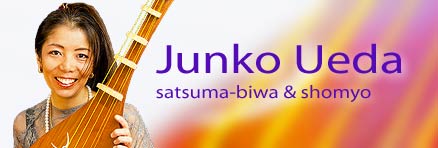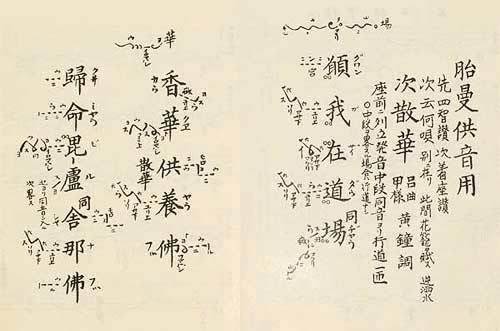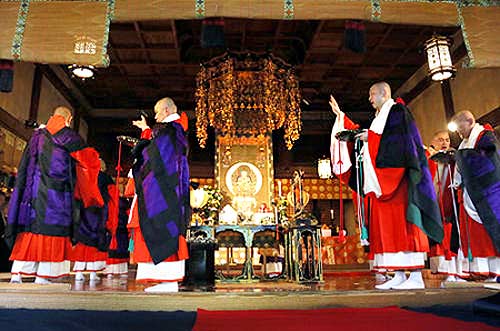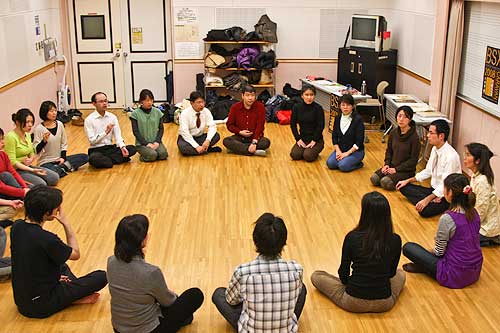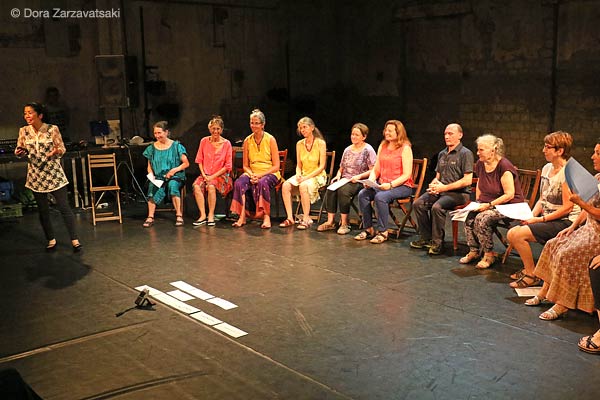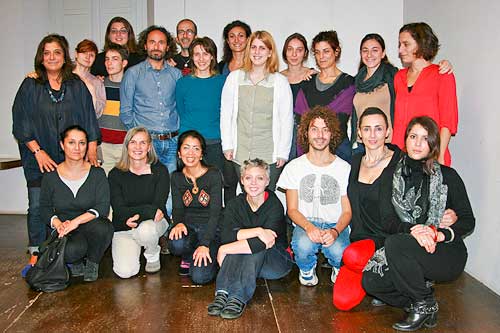Shomyo (聲明)
Here the Japanese Buddhist chant Shomyo is introduced in two chapters.
About Shomyo
Since old times, music has been an essential part of all kinds of ritual ceremonies and also shomyo is a ritual music. It is sung in a Buddhist ceremony by a group of Buddhist monks. The original form of shomyo was practiced in ancient India and after that, through Tibet, China and Korea, it arrived in Japan.

Since then, the shomyo singing tradition in Japan is succeeded till today without any break. There is a written record that on 8th of April in 752, there was a memorial service of the inauguration of the great Buddha statue at Tôdai-ji Temple in Nara, Japan and shomyo was sung by hundreds of monks in the ceremony. Shomyo is regarded as fundamental for all later Japanese traditional music, since most of Japanese traditional music is based on singing. At the same time, it is said that shomyo has historical relations with numerous ancient song styles in the world. Literally translated, the word “shomyo” combines the characters for “voice” and “wisdom”.
Samples of Buddhist chanting in Asia
A Japanese shomyo piece is constructed by melody patterns, each sung with one breath. Portamento and extended pitch-bending are one of the important elements to shape the melody patterns. Conceptually the melody patterns are regarded to remain in the space and filling the space. In this way, shomyo chanting creates its unique concept of time and space. When shomyo is sung by trained monks, their religious piety will be expressed through their voices, piling up time in the space.
Ancient Voices in a Contemporary Society
Sample from the CD 'Meditative Flowers' by Junko Ueda
 In this CD 'Meditative Flowers', Junko Ueda sings solo repertoire from the Tendai shomyo. Here below is a sound sample of the piece Kuyômon. More sound samples and information on the CD can be found at the CD page.
In this CD 'Meditative Flowers', Junko Ueda sings solo repertoire from the Tendai shomyo. Here below is a sound sample of the piece Kuyômon. More sound samples and information on the CD can be found at the CD page.Kuyômon - Junko Ueda

“When I encountered Japanese shomyo Buddhist chanting in the beginning of 1980s, I experienced an unforgettable sensation: apart from perceiving sound with the ears and the intellect, an intense mass of voices vibrated directly inside my whole body. Being captivated by shomyo chanting, I became a student of the great shomyo master Mr. Kôshin Ebihara, a celebrated monk of Tendai-shû Buddhist sect.
During these lessons, Mr. Ebihara often expressed the philosophy and the basis of his shomyo chanting: “Shomyo chanting can obviously be enjoyed as an art music. However, above all, the shomyo chanting is a most serious training and an expression of a religious feeling by a devout Buddhist person.” During years of daily practicing, one may gradually enter its profundity. While reflecting the words of the teacher, I could gradually explore some of this profundity and the significance of the shomyo chanting.
During practicing I realized that the breathing is the most essential necessity for human survival. The slow melismatic shomyo chanting makes you aware of the considerably extended length of breathing. This resembles to a religious act which gazes at the breathing as the root of human existence. Breathing is equal to the life. In other words, enjoying the breathing every moment is equal to enjoying the life. This seems to me an important message behind the shomyo chanting.
So what was that first sensation that caught me when listening to the shomyo chanting for the first time? Instead of a beautiful melody or some excellent musical virtuosity, I seemed to be touched by the power of a single breath, a power which made my body vibrate. It was the sensation of the breath ‘息’ (IKI), the spirit ‘意気’ (IKI) and the life ‘生き’ (IKI). Thinking about this, I sing shomyo once again. Then I feel thankfulness and happiness.
I would like to bring the voice of shomyo out of the Buddhist temple and to share my experience and thoughts about shomyo chanting. Also, I would like to approach to a world of universal sensitivity of human being through the expression of ‘the breath’ that has been nurtured in the Japanese culture.
The world of shomyo is extremely profound. I feel I have just started rowing out into the great ocean of shomyo chanting and it seems to take more time to be able to sail freely over this great ocean. However, exposing the power of breath in the shomyo Buddhist chanting may fill the heart of people with a moment of peace."
Junko Ueda
Repertoire by Junko Ueda
Tendai-Shomyo: Tendai-school Buddhist chanting
- Shichi-Bongo-san 四智梵語讃
- Shichi-Kango-san 四智漢語讃
- Sange (exsoteric) 散華(顕教用)乙様
- Sange (esoteric) 散華(密教用)甲用
- Taiyô 対揚
- Kuyômon 供養文
- Shoôrei 唱礼
- Kuhôben 九方便
- Godaigan 五大願
- Daisan 大讃
- Bussan 仏讃
- Hyakujisan 百字讃
- Hyakuhachisan 百八讃
- Shaten-kango-san 諸天漢語讃
- Sanrai 三礼
- Nyaraibai 如来唄
- Agekanjô 揚勧請
- Rokushuekô 六種回向
- Gonenmon 五念門(十二礼)
- Sankunenbutsu 三句念仏
- Kujôshakujô 九條錫杖
- Rokudô-Kôshiki 六道講式
Shomyo workshop

This workshop introduces the Japanese Buddhist chant Shomyo, which is originated from the 9th century. Under the guidance of Junko Ueda, the participants will practice how to sing some repertoires of Shomyo chant. Beside working on the musical aspects, a holistic approach is taken towards our universal human sense and spirit. We touch the subject about the essences of Japanese culture: those are Hara (the energy centre of the body) and Ma (space and timing). Also, some breathing exercises and body exercise (Qi-gong) are introduced and naturally integrated in the workshop. Anyone can join this workshop as no musical knowledge is required. Read more about Shomyo here.
The aim of the workshop:
- To enjoy group singing and a variety of voices.
- To experience the 1200-year-old Japanese ancient music and to explore its concept.
- To train consciousness and control of the breathing.
- To learn about the energy centre of the body called ‘Hara’ (Seika-Tanden) and to release the stress-level.
- To develop vocalization and body control (certainly useful for wind instrument players and vocalists).

Because of its style of slow melismatic Shomyo chanting, the participants will be stimulated to concentrate on their breathing in a quiet manner. While enjoying singing basic Shomyo melodies and meeting this ancient tradition, we will aim to discover the wisdom and the power of the breath, and its essence for humanity.
Since 1995, Junko Ueda has been presenting Shomyo workshops. Through promoting these ancient and universal melodies, she supports a global sustainability with thinking about good air as a primary importance to enjoy the breathing.
Beside, Junko Ueda presents the lecture about the shomyo Buddhist chant. She will explain its history and concept, and demonstrates some of the pieces.
Shomyo Workshop sound samples
Contents of the Workshop
- Warming up: breath and body exercises, focusing on breathing and Hara.
- Introduction of Shomyo: learning various Shomyo melody patterns and later singing musical variations using these melody patterns.
- Singing traditional Shomyo pieces: Practice 'Sange' and 'Taiyo'.
- Introduction of its history and various concepts of the Japanese culture.
Practical aspects
- The workshop can be held once, like a single event, or as a series of more workshops.
- Proposed duration for a one-time workshop: 3 hours
- Amount of participants: minimum 5
- It is recommended for the participants to wear any style of casual clothes (better avoid high heels and neck-ties).
- A workshop can be held in any quiet place with sufficient space to put chairs for the participants in a half circle. A white-board is needed.
- Language: English and Japanese, Spanish and Dutch.
Feedback
- “Very organic music. I feel very comfortable and relaxing to sing together.” (from enquête of a Shomyo workshop)
- "A very inspirational workshop." (from enquête of a Shomyo workshop)
- “It is amazing that so many different voice qualities can be together and make a music. There is no competition and no stress. You can just produce your voice as you feel like.” (from enquête of a Shomyo workshop)
- "An experience that whole my body is vibrating and healthily activated." (from enquête of a Shomyo workshop)
- "Standing next to the music with text and musical instructions, she played long ritual only with her voice. For fifty minutes the audience was holding their breath..." (from Shomyo concert, De Volkskrant, Holland)
Shomyo Workshops in the Past
- ‘Les Suds à Arles’ le festival de Musiques du Monde (Arles, France)
- Leo Kestenberg Musikschule im Haus am Kleistpark (Berlin, Germany)
- Ateliers d'Ethnomusicologie (Geneva, Switzerland)
- SOAS, University of London (London, UK)
- Hochschule für Musik Würzburg (Germany)
- Conservatoire National Supérieur de Musique de Lyon (France)
- De Singel, Conservatorium Antwerpen (Belgium)
- Athens National Concervatory (Athens, Greece)
- International Zen Buddhism Association, La Gendronnière (France)
- University of Montreal (Canada)
- Western Front (Vancouver, Canada)
- Mántica Theatre Festival (Cesena, Italy)
- Flagey, Brussels (Belgium)
- Conservatorio Superior de Granada (Granada, Spain)
- Aula de Musicas, music school (Madrid, Spain)
- Conservatorio profesional de musica de Getafe (Getafe, Spain)
- Carmen de San Onofre (Granada, Spain)
- Private lesson at Studio E (Amsterdam, Holland)
- World Music Festival Rotterdam (Rotterdam, Holland)
- Vooruit, Gent (Belgium) - at IETM conference 'OneOnOne'
- Arkas Concert Hall, Sasebo (Japan)
- Enmeiji Temple, Aoto (Tokyo, Japan)
- Drama Institute, at Shinjuku Olympic Centre (Tokyo, Japan)
- Dôgo Community Centre (Ehime, Japan)
- Daishô-an (Yamagata, Japan)
- Trunk Theatre (Tokyo, Japan)
PDF Download
Click on an image below to download the leaflet of the Shomyo Workshop PDF in the language of your preference.
For more information feel free to send a message at the Contact page.
Announcement
